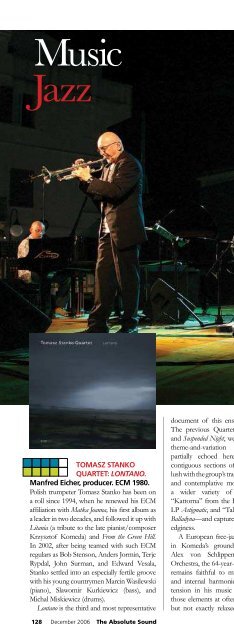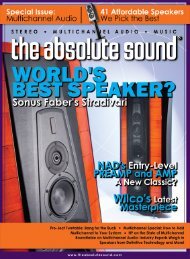You also want an ePaper? Increase the reach of your titles
YUMPU automatically turns print PDFs into web optimized ePapers that Google loves.
Music<br />
Jazz<br />
Extraordinary<br />
Excellent<br />
Good<br />
Fair<br />
Poor<br />
Music<br />
Sonics<br />
Tomasz Stanko<br />
Quartet: Lontano.<br />
Manfred Eicher, producer. ECM 1980.<br />
Polish trumpeter Tomasz Stanko has been on<br />
a roll since 1994, when he renewed his ECM<br />
affiliation with Matka Joanna, his first album as<br />
a leader in two decades, and followed it up with<br />
Litania (a tribute to the late pianist/composer<br />
Krzysztof Komeda) and From the Green Hill.<br />
In 2002, after being teamed with such ECM<br />
regulars as Bob Stenson, Anders Jormin, Terje<br />
Rypdal, John Surman, and Edward Vesala,<br />
Stanko settled into an especially fertile groove<br />
with his young countrymen Marcin Wasilewski<br />
(piano), Slawomir Kurkiewicz (bass), and<br />
Michal Miskiewicz (drums).<br />
Lontano is the third and most representative<br />
128 December 2006 The Absolute Sound<br />
document of this ensemble’s live sensibility.<br />
The previous Quartet discs, Soul of Things<br />
and Suspended Night, were essentially extended<br />
theme-and-variation suites, an approach<br />
partially echoed here in the three noncontiguous<br />
sections of the title track. While<br />
lush with the group’s trademark long lyrical lines<br />
and contemplative moods, Lontano explores<br />
a wider variety of ideas—reinterpreting<br />
“Kattorna” from the Komeda quintet’s 1965<br />
LP Astigmatic, and “Tale,” from Stanko’s 1975<br />
Balladyna—and captures more of the quartet’s<br />
edginess.<br />
A European free-jazz pioneer who played<br />
in Komeda’s groundbreaking quintet and<br />
Alex von Schlippenbach’s Globe Unity<br />
Orchestra, the 64-year-old Stanko nonetheless<br />
remains faithful to melody, albeit fractured,<br />
and internal harmonic structure. He builds<br />
tension in his music by abstractly aligning<br />
those elements at often exquisitely unhurried<br />
but not exactly relaxed tempos and in vast,<br />
yet somehow intimate spaces, and also by<br />
injecting the occasional mercurial run after<br />
long-held notes and legato phrases. Wasilewski<br />
(who’s rightly been cited as a latter-day Bill<br />
Evans), Kurkiewicz, and Miskiewicz, who<br />
have recorded together as Trio, are as in-synch<br />
with Stanko as Herbie Hancock, Ron Carter,<br />
and Tony Williams were with Miles Davis,<br />
whose bittersweet expressiveness Stanko<br />
nearly matches.<br />
Manfred Eicher’s transparent production<br />
places the instruments in realistic threedimensional<br />
relationships on a perfectly<br />
proportioned, deep, and not-too-wide<br />
soundstage, with warm, round bass and piano<br />
tones, shimmering cymbals, and glorious<br />
reproduction of Stanko’s typically silky<br />
trumpet. Derk Richardson<br />
Further Listening: Tomasz Stanko<br />
Septet: Litania: The Music of<br />
Krzysztof Komeda; Edward Vesala:<br />
Heavylife










